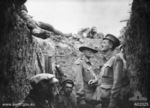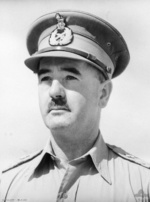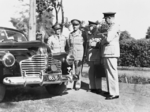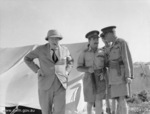Leslie Morshead
| Surname | Morshead |
| Given Name | Leslie |
| Born | 18 Sep 1889 |
| Died | 26 Sep 1959 |
| Country | Australia |
| Category | Military-Ground |
| Gender | Male |
Contributor: Morgan Bell
ww2dbaseStrategic victory over the Desert Fox, Germany's most celebrated general, Erwin Rommel, in the desert war in North Africa was achieved by the British Eighth Army, under the command of Bernard Montgomery. The fighting had raged between east and west for years before Montgomery's arrival, as Rommel drove the British back to Egypt, extending his own supply line, weakening the German and Italian Panzerarmee under his command, and in turn was driven back by successive British counter-offensives. The British supply lines were then over extended as well, faltering the counter-offensive. The desert war in North Africa fluctuated in this manner until Montgomery could build up his forces to crush German opposition in North Africa, and United States troops land at the rear of Rommel's army in Operation Torch, to be an anvil again which the British hammer blows might crush Rommel's army. Yet, many troops and officers, both British and Commonwealth, achieved tactical victories over the Desert Fox that contributed to Montgomery's strategic victory. The Australian Imperial Force's 9th Division, commanded by Leslie Morshead, contributed to a number of these tactical victories that frustrated Rommel's hard-pressed army, and etched their legend into the annals of brave military achievement in the Second World War. The most well-known of the 9th Division's achievements was as a strong core of the Commonwealth troops that conducted a successful defense of the strategic Mediterranean port city of Tobruk, denying Rommel a close port from which to resupply fuel to keep the tanks of his Afrika Korps running. They also handled a vital sector in the Allied efforts in the Battle of El Alamein. Winston Churchill was reluctant to give permission for their evacuation from Tobruk and release to Australia, despite repeated requests by the Australian authorities.
ww2dbaseBorn in Ballarat in central Victoria, Leslie James Morshead was one of seven children. His father's passing when Leslie was six years of age left the family impoverished, relying on his elder brother's income to survive. Leslie attended the Mount Pleasant School. Leslie Morshead was a fearless and enthusiastic competitor in local cricket and football teams, so inspiring his teammates. For these traits Morshead was chosen to be captain of both teams, rather than for sporting prowess. These were glimpses at leadership qualities that would be fully revealed in his later military career. He took a variety of jobs, as he keenly felt a sense of duty to support his widowed mother. He delivered newspapers for the local news agent, and often took tough seasonal or labouring work. Upon leaving high school, he had to move on from short-term jobs to think of a lifetime occupation, Morshead decided to follow the path to a teaching career. In 1905 he began at the lowest level in the Victorian education system, slowly working his way up, acquiring good report wherever he went. Many teachers became officers in the cadets, and Morshead was no exception. In an unusual quirk of fate Leslie Morshead was being introduced to a path that would engage his leadership qualities more amply, he was being immersed in his destiny.
ww2dbaseWhen Britain joined the First World War in 1914, Morshead was teaching at Melbourne Grammar. The timing closely coincided, with Morshead reconsidering the teaching profession, so he resigned and traveled to Sydney to sign up with the 1st AIF. He enlisted as a private in the 2nd Battalion, he would have to earn the position of officer that he desired through patience and military achievement, when he landed at Gallipoli on 25 April 1915, Morshead had attained the rank of captain, achieving the rank of major after he fought at Lone Pine in August. As the campaign in Gallipoli drew to a close, Morshead was promoted to the command of the 33rd Battalion, which he successfully led in battles at Messines, Villers-Bretonneaux and Amiens during the final years of the First World War. Morshead's military service in the First World War did not end there, he served on Monash's staff for the demobilization of Australian troops, himself sailing for Sydney, arriving in December 1919. In 1921 Leslie Morshead married an old friend, Myrtle Woodside, eight years his junior. He decided to take up the offer of a soldier settlement block of 23,000 acres in western Queensland. With no prior experience in cattle farming and insufficient capital, Morshead soon discovered similar difficulties that many returned soldiers did. It was not long before the banks refused credit, disappointed Morshead returned to Sydney. The government granted him a war gratuity either in the form of a lump sum payment or Treasury Bonds maturing in 1924, attracting substantial interest. He displayed an aptitude for business and management by accepting the bonds. Morshead gained employment as a clerk with a British shipping company. He maintained contacts within the army, he was placed in command of the 19th Battalion in 1921. This battalion was part of Gordon Bennett's infantry brigade. Morshead was courted by a number of conservative political groups, which tried to ascertain his suitability for seats in state or federal parliaments. He was appointed passenger manager of the Sydney office of the Orient Line shipping company in 1926, then publicity manager in 1927.
ww2dbaseWhen Britain declared war in September 1939, Orient Line expected their ships to be called into service any minute, so ordered the conversion of their eight passenger vessels into troopships. Morshead was managing the conversions in Sydney Harbour by the time Australia declared war, not knowing that he may be in the hull of one of those ships in May 1940, bound for distant lands. On 6 October 1940 Morshead received a telegram informing him that he was being offered the command of the 18th Infantry Brigade in the 2nd AIF, he accepted and signed up. The brigade was based in south-east England during the Battle of Britain. Morshead was overlooked for promotion to major-general and the position of commander of AIF Administrative Headquarters. Instead the position went to H. D. Wynter, a brigade officer who harboured some animosity for Morshead, and vice versa. In October Wynter became ill, so Morshead was acting commander in AIF Administrative Headquarters. Wynter's illness persisted, so Blamey ordered him to return to Australia. This turn of events had been fortuitous for Morshead, as this ensured he was the senior brigadier in the 2nd AIF when a commander for the 9th Division was required, so Morshead seemed like the logical choice. On 27 January Blamey confirmed Morshead for a promotion to the rank of major-general, as well as to the position of CO of the 9th Division. The command was an alternative paradigm to the one he held in the 18th Infantry Brigade, instead of a single infantry brigade there was three, plus support, such as artillery and, if they did not lack the resources, armour. Morshead had been transferred from one of the AIF's most disciplined and best equipped brigades to a division that was a diverse contingent of troops tacked together from men recruited from diverse regions of Australia, that lacked extensive military training and modern equipment. The 9th Division consisted of recently recruited men, many whom had received little prior military training, and who felt like the unwanted dregs of the AIF recruitment drive. Morshead had to begin training them in matters of military discipline upon assuming divisional command, and instill within them a confidence in their own abilities. He assumed command at divisional headquarters in Julis, Palestine, where he met his brigade commanders, on 5 February, around the same time Generalleutnant Erwin Rommel was appointed commander of the Afrika Korps in Germany. The British, defending Egypt, drove the Italians back to Benghazi. Hitler promised assistance to his beleaguered Italian allies, so the Afrika Korps were dispatched to North Africa. On 31 March, defying orders from Berlin, Rommel launched a counter-offensive. The campaign in Greece had weakened the Commonwealth position in North Africa, and British forces were left reeling back to Egypt, where they had begun. The 9th Division had been left in Tobruk with brigades of the AIF's 7th Division, and a further 10,000 other Commonwealth and Allied troops. On 11 April, a substantial amount of Rommel's army had surrounded the city. With the overland routes blocked by the enemy, supplies had to be shipped in reinforcements and supplies in merchant and naval vessels, which included a number of RAN destroyers. With the Luftwaffe dominating the skies over Tobruk, many supplies did not arrive in Tobruk. The HMAS Waterhen, HMAS Parramatta, and 21 smaller vessels were sunk in the efforts to supply the town via the Tobruk ferry. Morshead was aggressive about the defence, conducting patrols and raids in the unoccupied land between the armies. He often spoke about making "no man's land our land". Morshead told his brigade commanders "There'll be no Dunkirk here. If we should have to get out, we shall fight our way out. There is no surrender and no retreat". After this a British soldier compared Rommel to a marauding wolf outside Tobruk and Morshead to the shotgun inside the besieged town, or both men as pugilists engaged in a titanic boxing match, "the Undefeated Blitzkrieg Boy versus the No Dunkirk Here Bloke from Down Under". Not only capturing the imagination of lowly Allied troops, Allied leaders such as Winston Churchill did not fail to see the significance of Morshead's leadership in the siege of Tobruk. Churchill cabled Roosevelt:
ww2dbaseThe Australian war correspondent, Chester Wilmot, described Morshead's tactical leadership after witnessing it first hand:
ww2dbaseWavell arrived at Tobruk shortly after the siege started, and Morshead wrote of the visit, when, as Morshead recalls, Wavell and Morshead
ww2dbaseFar surpassing Wavell's eight week estimate, the defenders held Tobruk for eight months, during which the Australians suffered 3,009 casualties, with 941 taken prisoner. The German propagandist, William Joyce, dubbed the defenders "the Rats of Tobruk", intended to be derogatory, but the label was worn with pride by the Australians, as a badge of honour. Many Allied troops were involved in the defence, the Australians' adoption of the term indicates the outlook of the diggers, as well as an obscure sense of humour in difficult circumstances. Despite Morshead's bravado, he reported a high level of deterioration of health and discipline amongst the defenders under his command. This prompted Blamey to request the 9th's evacuation from Auchinleck, who refused, knowing that would leave Rommel free to conduct another counter-offensive towards Cairo. Blamey urged the Australian acting prime minister, Arthur Fadden to request that Churchill intervene. On 15 September Fadden cabled Churchill that the Australian government wanted the 9th Division removed. Churchill refused, citing the poor position that would leave the Middle East in, and arguing such a move would reflect badly on Australia after the sacrifices Australians had made so far. Churchill finally agreed with his Australian counterpart, for he feared a reaction in Australian and world opinion against Britain seeming to fight all its battles in the Middle East with dominion troops. Blamey and Fadden's attempts to get Auchinleck and Churchill to agree to the relief of the 9th Division slowly filtered through the military and political bureaucracy, over August, September and October the 9th Division were relieved by sea. The Australian division had amounted to about two thirds of the defending troops in Tobruk, the rest being made up from a range of Allied nations: Britain, Poland, and India. In the end, the decision for relief was as much political as military. On 22 October, Morshead handed command of the town's garrison to Major-General Ronald Scobie and his 70th British Division. Finally out of the port city that Morshead called home for eight month, he was informed of his promotion to the rank of lieutenant general. When John Curtin became prime minister in 1941, he endorsed Morshead's effort before the Australian parliament, saying "When the history of this war is written, the epic of Tobruk will certainly be one of its most glorious pages". That was not Morshead and the 9th Division's only contribution to the desert war. In the Second Battle of El Alamein, they fought in the coastal position, in the northern sector of the battlefield. British commander Bernard Montgomery praised them, adding "I don't know of any [other] Allied Division who could have done it". The British command attempted to split up the brigades of the 9th Division amongst British Divisions, but Morshead remembered Blamey's orders on this matter and resisted the British attempts. Altogether the 9th Division suffered 2,694 casualties during the Second Battle of El Alamein, which was two percent of the Allied casualties suffered in that battle, so it had already suffered noticeable losses before the British General Staff wanted to cannibalise Australian brigades. The 9th Division amounted to ten percent of the Eighth Army, so their casualties would have seemed high to the division's troops. With acclaim for his leadership at Tobruk, and now El Alamein, countries from all over the world that despised Nazi Germany took notice of Morshead. Lincoln University in the United States requested an autographed photograph of Morshead to include in a collection of similar photographs of great men, past and present. The head of the Polish government in exile, Wladyslaw Sikorski awarded Morshead the Virturi Militari. The 9th Division's confidence in Morshead was higher at El Alamein than at Tobruk, El Alamein was when Rats of Tobruk developed a strong divisional spirit.
ww2dbaseAs the Battle of El Alamein was not over until late 1943, Morshead and the 9th Division could not return to Australia until that year, by which time Australia's years of most urgent crisis had passed. Morshead and his division were still needed as the defeat of Japan inched ever closer. The 9th Division was proud of their victories at Tobruk and the coastal sector of El Alamein, but they were happy to be heading home, Morshead was no exception. He had family he had not seen in three years. As they crossed the Indian Ocean, they encountered four battleships and several cruisers of the British Far Eastern Fleet on 10 February. Knowing Morshead was aboard the troopship, the British admiral sent a signal that read "Rommel will be relieved but the Japs will have jim-jams. In case I don't sight you again, au revoir until we meet in Tokyo". Morshead set foot in Freemantle in Western Australia on 19 February, amid celebration and fanfare as his countrymen gave him a heroes welcome upon his arrival home. He was met by Gordon Bennett, who briefed him on the situation Australia was in with Japanese aggression and United States troops in Australia. The following day Morshead flew to Melbourne, where he was reunited with family. On 21 February Morshead had a meeting with Blamey, unaware that Blamey had previously told Curtin
ww2dbaseMorshead and Blamey discussed several matters openly, including Morshead's allowance of 750 pounds, junior appointments, and corps command. Morshead was to be assigned CO of II Corps. A corps command was very different from divisional command. Besides leading two divisions, the command structure changed constantly. A corps was assigned to an operation, then assigned divisions appropriate to the task, which was a change from the respect Morshead earned from the 9th Division through familiarity of his personality and values. He spent the next few weeks with family and friends, before going to Sydney's Victoria Barracks to undertake some administrative duties. When he was done, Morshead went to the docks at Wooloomaloo to greet the New South Wales contingent of the 9th Division, for a happy reunion and a warm welcome back home. The soldiers of the 9th Division were delighted to hear that Morshead had been rewarded with a corps, but it quickly became disappointment when they realized that meant Ali Baba was leaving his Twenty Thousand Thieves (Berlin radio's label for Morshead and the 9th Division was "Ali Baba Morshead and his twenty thousand thieves). On 10 March, Morshead traveled to the Atherton Tableland, in far northern Queensland, the site of II Corps training ground in preparation for operations on the Huon Peninsula in New Guinea. Australian historian, David Day, has suggested that Blamey saw Morshead as a threat to his position of commander-in-chief of the Australian army, so promoted him to command of II Corps, sending him to an out of the way place such as the Atherton Tablelands. On his way there he stopped at Brisbane, visiting Blamey, and meeting MacArthur for the first time. Morshead wrote that MacArthur
ww2dbaseHe traveled to Cairns to assume command of II Corps for training exercises. The 7th and 9th Divisions were assigned to II Corps. A whole new set of conditions needed extensive training. Jungle warfare presented different problems and required different tactics to desert warfare. The coastal areas in northern Queensland served to acclimatize troops into conditions in New Guinea. Morshead tried to emulate battlefield conditions in New Guinea as closely as possible: snipers disguised as their Japanese counterparts, mock Japanese graves. Specialist training was also given for amphibious landings, a relatively new development that required training from American officers. The Huon Peninsula was deemed strategically necessary by MacArthur as a stepping stone for the conquest of Rabaul. I Corps under the command of Lieutenant-General Edmund Herring had unsuccessful operations on the Huon Peninsula previously due to outbreaks of malaria and lack of co-operation between Australian and American officers. Malaria was restricted through discipline in health matters. The latter problem was overcome when II Corps took over operations on the peninsula, Morshead had an congenial nature and his reputation preceded him. Morshead developed close friendships with United States generals Robert Eichelberger, commander of the US Eighth Army, and Walter Krueger, commander of the US Sixth Army. This was not an assignment without risks for Morshead, on 8 June the plane he was in was almost shot down when it was attacked by a number of Japanese aircraft. Only skillful evasive action by the pilot meant Morshead could live to tell the tale. The training exercises proved fruitful, on 4 September the 9th Division performed a successful amphibious landing near Lae, which was wrested from Japanese control on 18 September. The day after the division's landing, 5 September, American paratroopers captured the airfield at Nadzab. By 7 September the Americans had the Nadzab airfield fully operational. Under the training and discipline Morshead implemented, the Huon Peninsula was gradually swept of Japanese presence, and came under Allied control.
ww2dbaseIn May 1944, Morshead was assigned to I Corps, a prestigious command. In I Corps, the affectionate nicknames he was known by his soldiers, such as "Ali Baba" or "Les", were replaced by the nickname "Ming the Merciless" by his staff, alluding to the discipline he enforced. I Corps consisted of the 6th, 7th and 9th Divisions. Blamey had formed it of these divisions in the hopes that MacArthur would use them in the Philipines, but MacArthur's ego prevented him from using non-American forces in the struggle to retake the Philippines. This meant the Australian people were funding an army that was not doing much. Curtin was a sick man with little fight left in him, so he could not strongly question MacArthur. Morshead handed over the command of II Corps to General Stanley Savige, and I Corps was to conduct operations in Borneo. It was one of the last operations in the SWPA that the Australian Army was involved in. Politically Borneo aroused controversy. Australians were puzzled why their country was fighting there. The operations seemed pointless and wasteful. Tactically, the operations were flawlessly conducted. Working in conjunction with the United States Navy, but I Corps retained tactical control, being responsible to MacArthur's advance headquarters in Manila, liaising through Blamey. After the war which Morshead had contributed so much to, he chaired a military court of inquiry into Major-General Gordon Bennett's departure from Singapore in 1942. Refusing military and diplomatic posts, Morshead became manager of the NSW branch of the Orient Line. He was diagnosed with cancer in the fifties, and the leader of the Rats of Tobruk lost his last battle before the decade was through, dying in 1959.
ww2dbaseSources: D. Coombes, Morshead: Hero of Tobruk and El Alamein, the Australian War Memorial, J. Beamont, Australia's War: 1939-45, D. Day, The Politics of War, P. Thompson, Pacific Fury.
Last Major Revision: Sep 2008
Photographs
 |  |  |  |
Leslie Morshead Timeline
| 18 Sep 1889 | Leslie Morshead was born. |
| 26 Sep 1959 | Leslie Morshead passed away. |
Did you enjoy this article or find this article helpful? If so, please consider supporting us on Patreon. Even $1 per month will go a long way! Thank you. Share this article with your friends: Stay updated with WW2DB: |
Visitor Submitted Comments
All visitor submitted comments are opinions of those making the submissions and do not reflect views of WW2DB.
» Siege of Tobruk
» New Guinea-Papua Campaign, Phase 3
» Borneo Campaign
- » 1,150 biographies
- » 337 events
- » 44,024 timeline entries
- » 1,241 ships
- » 350 aircraft models
- » 207 vehicle models
- » 375 weapon models
- » 123 historical documents
- » 260 facilities
- » 470 book reviews
- » 28,571 photos
- » 432 maps
Winston Churchill
Please consider supporting us on Patreon. Even $1 a month will go a long way. Thank you!
Or, please support us by purchasing some WW2DB merchandise at TeeSpring, Thank you!
13 Mar 2013 05:09:23 AM
I am interested in finding out the data about Sons and Daughters of General Morsehead Austrailian General Division WWII. Also if any body of them is alive (What and Where) Thanks and regards.